|
|
|
Sort Order |
|
|
|
Items / Page
|
|
|
|
|
|
|
| Srl | Item |
| 1 |
ID:
075386
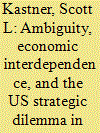

|
|
|
|
|
| Publication |
2006.
|
| Summary/Abstract |
As tensions across the Taiwan Strait have risen in recent years, some have argued that the US policy of strategic ambiguity-under which Washington leaves unclear if and how it would intervene in a cross-Strait conflict-has outlived its usefulness because ambiguity may foster dangerous misperceptions about US intentions and hence contribute to future crises. In this essay I critically examine strategic ambiguity, and conclude that ambiguity remains the best policy available to Washington given current US goals in the Taiwan Strait. I argue that ambiguity remains essential both to deterring a Chinese attack and to restraining Taiwanese moves toward independence, but that it nonetheless carries with it inherent risks of conflict. I further argue, however, that these additional risks triggered by ambiguity per se are likely small, and hence are overshadowed by the strategic obstacles faced by the alternatives to an ambiguous policy. Moreover, I show that growing economic interdependence between Mainland China and Taiwan further reduces the risk that ambiguity itself would be a contributing factor to war in the Taiwan Strait. As such, the relative attractiveness of ambiguity has likely increased, rather than decreased as argued by its critics, over the past decade.
|
|
|
|
|
|
|
|
|
|
|
|
|
|
|
|
| 2 |
ID:
103099
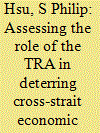

|
|
|
| 3 |
ID:
158740
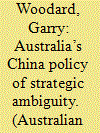

|
|
|
|
|
| Summary/Abstract |
History, little understood, shows that for 55 years a policy of ‘strategic ambiguity’ about the application of the Australia, New Zealand, United States Security Treaty to Taiwan, a flashpoint in Asia, served Australia well. Return to it could lessen the risks of embroilment in any Sino-American war in East Asia, and enhance Australia’s middle-power options.
|
|
|
|
|
|
|
|
|
|
|
|
|
|
|
|
| 4 |
ID:
179178
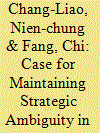

|
|
|
|
|
| Summary/Abstract |
For decades, one key dimension of US policy toward Taiwan has been “strategic ambiguity.”1 With its equivocal reassurance in defending Taiwan, while recognizing there is “one China,” Washington has sought both to prevent Beijing from launching an unprovoked attack on the island and to dissuade Taipei from declaring the island’s de jure independence from the mainland. Since Washington established diplomatic ties with the PRC in 1979, this policy has allowed the United States to maintain cooperative and beneficial relationships with both sides of the Taiwan Strait, contributing to peace and prosperity in the region.
|
|
|
|
|
|
|
|
|
|
|
|
|
|
|
|
| 5 |
ID:
103100
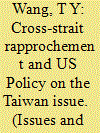

|
|
|
| 6 |
ID:
172698
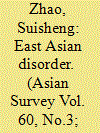

|
|
|
|
|
| Summary/Abstract |
In the South China Sea territorial disputes, China has shifted from a delaying strategy characterized by strategic ambiguity to strategic clarity and an increasingly assertive stance. Yet, this power play, asserting sovereignty over a large portion of the South China Sea, has not prompted a decisive push-back from regional states or major powers, raising the question of what kind of norms China will bring to the regional order and indicating the difficulty of building rules-based order in a region characterized by unbounded power politics in a twenty-first-century Hobbesian struggle.
|
|
|
|
|
|
|
|
|
|
|
|
|
|
|
|
| 7 |
ID:
188942
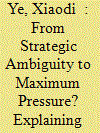

|
|
|
|
|
| Summary/Abstract |
How do changes in US Taiwan policy play out? What is the logic behind these changes? To address these questions, existing studies have formulated four schools of explanation, providing valuable theoretical insights. However, these studies have obvious problems with unidirectional dichotomy and thus fail to identify a causal mechanism explaining the long-term trajectory of US Taiwan policy. This article conducts a re-typology of US Taiwan policy to break the traditional strategic ambiguity–clarity dichotomy by establishing three key indicators and argues that the orientation of US China policy and Taiwan’s US policy are the two major factors triggering changes. By conceptualizing and operationalizing the two independent variables as engagement-oriented, coopetition-oriented, containment-oriented, and hedging/bandwagoning/binding, this article develops a systemic theoretical framework to demonstrate how the US Taiwan policy transits between strategic clarity, maximum pressure, partial strategic clarity, between partial strategic clarity and strategic ambiguity, strategic ambiguity, and controlling the pro-independent forces. This article conducts empirical studies by reviewing the transition of US Taiwan policy under different presidencies in post–Cold War era to demonstrate how the theoretical framework works in realpolitik.
|
|
|
|
|
|
|
|
|
|
|
|
|
|
|
|
| 8 |
ID:
133725
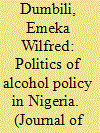

|
|
|
|
|
| Publication |
2014.
|
| Summary/Abstract |
The global call by the World Health Assembly (WHA) to control the rising alcohol-related problems caused by harmful consumption became necessary in 2005 due to the recognition of the fact that many countries did not have alcohol policies. This gave rise to the adoption of a 10-point policy strategy by the World Health Organization (WHO) Member States in 2010. Against this backdrop, many countries adopted alcohol policies to reduce harmful alcohol consumption. Nigeria was one of the WHO Member Countries that adopted the resolution. Globally, Nigeria is among the 30 countries with the highest per capita consumption and alcohol-related problems, yet has not formulated alcohol policy to date. This paper draws on Eisenberg's Strategic Ambiguity Model to explore the role of brewers in supplanting alcohol policy initiatives in Nigeria. It argues that the leading alcohol producers in Nigeria have been the main reason alcohol policies have not been formulated. The article focuses on why their campaigns for responsible drinking, promotions, sponsorships and 'strategic social responsibilities' may have increased since the WHA made the call and the WHO adopted the resolution in 2010. It concludes by arguing that there is an urgent need to formulate policies drawing from the WHO resolution to curtail the activities of these brewers and reduce harmful consumption.
|
|
|
|
|
|
|
|
|
|
|
|
|
|
|
|
| 9 |
ID:
095556


|
|
|
|
|
| Publication |
2010.
|
| Summary/Abstract |
The US strategic ambiguity versus clarity has been a centerpiece in maintaining cross-strait stability since the 1995-96 Taiwan Strait crisis. Dialogues and debates abound regarding the relative effectiveness of discrete US policy choices. The current thaw in cross-strait relations does not forestall decisively the resurgence in the long run of the cross-strait tensions during 2000-08, rendering the strategic ambiguity/clarity still a relevant issue. This article argues that the discussions on the issue are seriously plagued by the lack of a sufficiently rigorous and commonly shared conceptualization of strategic ambiguity/clarity, and an internal logical contradiction or an inadequate practical utility as a tool to aid policy-making. To address these problems, this article seeks to clarify and elaborate on the conceptual foundation of strategic ambiguity/clarity by differentiating between two distinct analytic levels thereof, and proposing a conceptual framework for a fuller understanding of the US policy along various dimensions. It also reappraises some major issues or problems found in the existing discussions and US practice, and suggests possible solutions.
|
|
|
|
|
|
|
|
|
|
|
|
|
|
|
|
| 10 |
ID:
178113


|
|
|
|
|
| Summary/Abstract |
The notion of strategic ambiguity has long guided the United States’ engagement in cross-strait relations, requiring that Washington is intentionally unclear about whether and how it would intervene in a China–Taiwan conflict in order to preserve a balance of assurance and deterrence for both sides. This article unpacks the US approach to strategic ambiguity under Trump. Adopting a neo-classical realist perspective, it argues that domestic and individual level drivers—in particular, US populism, Congress and the foreign policy establishment, and Trump's transactional and personalized approach to foreign policy—have interacted with the shifting US–China balance of power to produce a different mode of American strategic ambiguity in the Taiwan Strait. A common view is that as a function of the growing US–China power competition, the US has largely leaned towards Taiwan in recent years. Our analysis revises this assessment by revealing a form of strategic ambiguity under Trump that, despite appearing to upset the balance of ambiguity in favour of Taiwan—paradoxically and probably unintentionally—maintains assurances and warnings for both China and Taiwan. Yet, while Trump has arguably preserved the overall balance of strategic ambiguity, he has introduced greater volatility into cross-strait relations.
|
|
|
|
|
|
|
|
|
|
|
|
|
|
|
|
| 11 |
ID:
193222
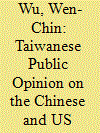

|
|
|
|
|
| Summary/Abstract |
Since 2016, China has been conducting military flybys around Taiwan, while the US has approved arms sales to Taiwan on several occasions and sent warplanes and battleships through the Taiwan Strait. How does Taiwanese public opinion respond to the Chinese and US military presence in the Strait? Is the public likely to become less supportive of de jure independence for Taiwan on account of China's military deterrence or more supportive owing to a perceived likelihood of US military assistance? In this report, we provide answers to these questions based on evidence from a survey experiment conducted in Taiwan in October–November 2020. We find that Taiwanese are less sensitive to the Chinese military presence in the Taiwan Strait but have become more supportive of de jure independence after seeing the US aircraft in the area. Our findings contribute to studies of cross-Strait relations and US foreign policy on the Taiwan Strait.
|
|
|
|
|
|
|
|
|
|
|
|
|
|
|
|
| 12 |
ID:
078199
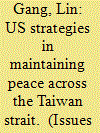

|
|
|
|
|
|
|
|